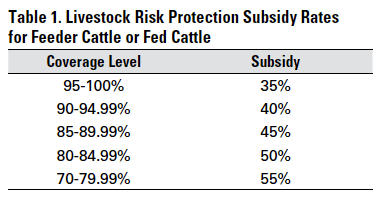Navigating Organization Risks with Bagley Risk Management
Navigating Organization Risks with Bagley Risk Management
Blog Article
Understanding Animals Danger Protection (LRP) Insurance Policy: A Comprehensive Overview
Browsing the realm of animals threat protection (LRP) insurance coverage can be a complex venture for many in the farming industry. From exactly how LRP insurance operates to the different insurance coverage options available, there is much to reveal in this thorough guide that might possibly shape the way livestock manufacturers approach risk administration in their organizations.

How LRP Insurance Coverage Works
Sometimes, understanding the mechanics of Livestock Risk Protection (LRP) insurance can be complicated, yet breaking down exactly how it works can give quality for farmers and ranchers. LRP insurance is a risk administration tool made to safeguard livestock producers against unexpected cost decreases. It's essential to keep in mind that LRP insurance coverage is not a profits guarantee; rather, it concentrates only on rate risk protection.
Eligibility and Coverage Options

When it comes to coverage choices, LRP insurance coverage uses manufacturers the flexibility to select the coverage degree, protection period, and endorsements that finest match their risk monitoring needs. By recognizing the qualification standards and coverage options readily available, animals producers can make enlightened decisions to handle threat efficiently.
Advantages And Disadvantages of LRP Insurance Policy
When assessing Livestock Threat Protection (LRP) insurance coverage, it is vital for livestock producers to consider the advantages and downsides intrinsic in this threat administration device.

One of the key advantages of LRP insurance coverage is its capability to give defense versus a decline in livestock prices. Additionally, LRP insurance policy supplies a level of versatility, allowing manufacturers to customize insurance coverage levels and plan durations to fit their specific demands.
Nonetheless, there are likewise some drawbacks to take into consideration. One limitation of LRP insurance is that it does not secure versus all kinds of risks, such as illness outbreaks or all-natural calamities. Furthermore, premiums can often be pricey, specifically for producers with huge animals herds. It is important for manufacturers to very carefully analyze their individual danger exposure and monetary situation to figure out if LRP insurance coverage is the ideal risk management device for their operation.
Comprehending LRP Insurance Policy Premiums

Tips for Making The Most Of LRP Conveniences
Optimizing the advantages of Animals Risk Security (LRP) insurance policy requires tactical planning and positive danger management - Bagley Risk Management. To maximize your LRP insurance coverage, think about the adhering to suggestions:
Frequently Assess Market Problems: Keep notified regarding market fads and price changes why not check here in the animals industry. By keeping track of these factors, you can make enlightened choices about when to acquire LRP protection to secure versus potential losses.
Set Realistic Coverage Levels: When choosing coverage degrees, consider your manufacturing costs, market price of animals, and prospective risks - Bagley Risk Management. Establishing reasonable coverage degrees guarantees that you are sufficiently secured without overpaying for unneeded insurance
Diversify Your Coverage: Instead of counting solely on LRP insurance coverage, take into consideration expanding your danger management approaches. Incorporating LRP with various other risk administration tools such as futures agreements or choices can provide extensive coverage against market uncertainties.
Evaluation and Change Protection Regularly: more tips here As market problems change, periodically examine your LRP coverage to ensure it lines up with your current danger exposure. Adjusting insurance coverage levels and timing of acquisitions can aid enhance your risk security strategy. By complying with these suggestions, you can make best use of the advantages of LRP insurance coverage and protect your livestock procedure against unforeseen dangers.
Final Thought
In conclusion, livestock threat security (LRP) insurance is a beneficial tool for farmers to take care of the economic threats connected with their animals operations. By comprehending how LRP functions, eligibility and coverage choices, along with the benefits and drawbacks of this insurance coverage, farmers can make educated decisions to shield their incomes. By meticulously considering LRP costs and implementing techniques to take full advantage of advantages, farmers can alleviate potential losses and guarantee the sustainability of their operations.
Animals producers interested in getting Livestock Risk Security (LRP) insurance coverage can check out an array of qualification requirements and protection options customized to their specific animals procedures.When it comes to coverage options, LRP insurance policy provides manufacturers the versatility to choose the insurance coverage degree, protection duration, and endorsements that finest fit their danger administration needs.To grasp the intricacies of Livestock Threat Protection (LRP) insurance completely, comprehending the aspects influencing LRP insurance premiums is essential. LRP insurance policy premiums are identified by various components, consisting of the protection level picked, the anticipated rate of animals at the end of the protection period, the type of animals being important site guaranteed, and the size of the protection period.Testimonial and Adjust Coverage On a regular basis: As market problems change, occasionally examine your LRP protection to ensure it straightens with your present danger exposure.
Report this page